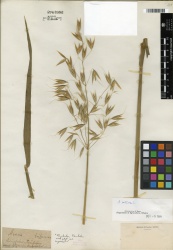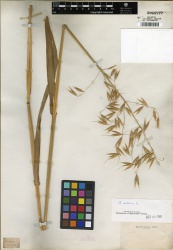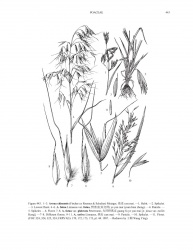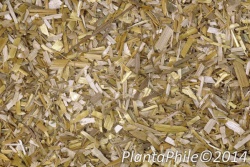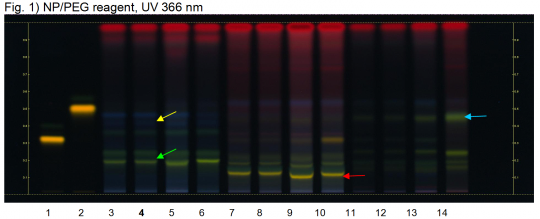Avena sativa (herb)
(add askbox) |
(add PlantaPhile references) |
||
| Line 32: | Line 32: | ||
=Macroscopic Characteristics= | =Macroscopic Characteristics= | ||
| − | {{Macroscopy | source=MOBOT, Tropicos.org | + | |
| + | {{ Media2 | cat=Macroscopy | ||
| + | | source=MOBOT, Tropicos.org | ||
| mainimage=Avena sativa Tropicos 84498.jpg | | mainimage=Avena sativa Tropicos 84498.jpg | ||
| companyimage=TropicosLogo.gif | | companyimage=TropicosLogo.gif | ||
| Line 38: | Line 40: | ||
| caption1=''Avena sativa'' - Tropicos.org - Flora of China Illustrations vol. 22, fig. 443, 9-11 | | caption1=''Avena sativa'' - Tropicos.org - Flora of China Illustrations vol. 22, fig. 443, 9-11 | ||
| description=Oat (herb) (''Avena sativa'') | | description=Oat (herb) (''Avena sativa'') | ||
| − | + | ||
| − | | | + | | source2=PlantaPhile |
| − | | | + | | image2=PlantaPhile - 2638.jpg |
| − | | | + | | companyimage2=PlantaPhile logo.jpg |
| − | | | + | | companyURL2=http://plantaphile.com/ |
| }} | | }} | ||
=Microscopic Characteristics= | =Microscopic Characteristics= | ||
Latest revision as of 23:04, 5 May 2015
Contents |
Nomenclature
Avena sativa L. Poaceae
Standardized common name (English): oat
Botanical Voucher Specimen
|
|
|
Organoleptic Characteristics
Macroscopic Characteristics
|
|
|
Microscopic Characteristics
High Performance Thin Layer Chromatographic Identification
|
Oat (herb) (Avena sativa) Lane Assignments Lanes, from left to right (Track, Volume, Sample):
Reference Sample(s) Reference: Dissolve 1 mg of rutin in 1 mL of methanol; Dissolve 1 mg of hyperoside in 1 mL of methanol. Stationary Phase Stationary phase, i.e. Silica gel 60, F254 Mobile Phase Formic acid, water, methyl ethyl ketone, ethyl acetate 10:10:30:50 (v/v/v/v) Sample Preparation Method Sample: Mix 500 mg of powdered sample with 5mL of methanol and sonicate for 10 minutes, then centrifuge or filter the solutions and use the supernatants / filtrates as test solutions. Derivatization reagent: 1.) NP reagent, Preparation: 1 g of natural products reagent in 200 mL ethyl acetate; 2.) PEG reagent, Preparation: 10 g of polyethylene glycol 400 in 200 mL dichloromethane, Use: Heat plate 3 min at 100°C, then dip (time 0, speed 5) in NP reagent, dry and dip (time 0, speed 5) in PEG reagent. Detection Method Saturated chamber; developing distance 70 mm from lower edge; relative humidity 33% Other Notes Images presented in this entry are examples and are not intended to be used as basis for setting specifications for quality control purposes. System suitability test: Rutin: orange fluorescent zone at Rf ~ 0.32. Hyperoside: orange fluorescent zone at Rf ~ 0.50. Identification: Compare result with reference images. The fingerprint of the test solution is similar to that of the corresponding botanical reference sample. Additional weak zones may be present. Between the orange zones corresponding to references rutin and hyperoside the chromatogram of the test solution shows two faint blue zones at Rf ~ 0.42 and Rf ~ 0.46 (yellow arrow) and below them a faint greenish zone. Below reference rutin there are two green zones at Rf ~ 0.25 and Rf ~ 0.18 (green arrow). A prominent red zone is located close to the solvent front. Test for other species: No zone is seen between the application position and the green zone at Rf ~ 0.18 (Barley grass, red arrow). No green zone is seen at Rf ~ 0.44 (Wheat grass, blue arrow).
|
Supplementary Information
Sources
- ↑ MOBOT, Tropicos.org http://www.tropicos.org/Image/100251984
- ↑ MOBOT, Tropicos.org http://www.tropicos.org/Image/100251978
- ↑ MOBOT, Tropicos.org http://www.tropicos.org/Name/25509314
- ↑ PlantaPhile http://plantaphile.com/
- ↑ HPTLC Association http://www.hptlc-association.org/
